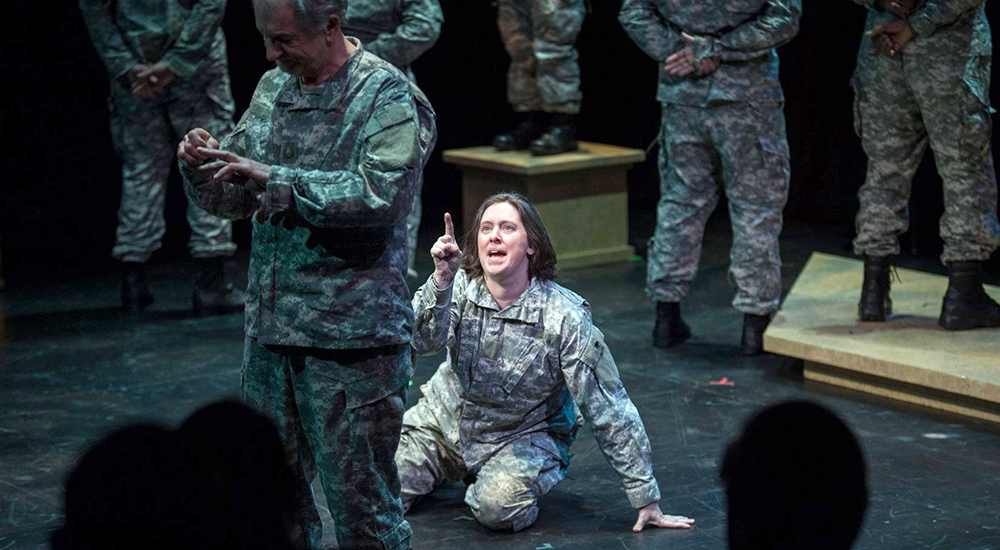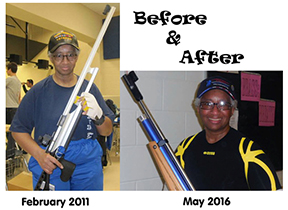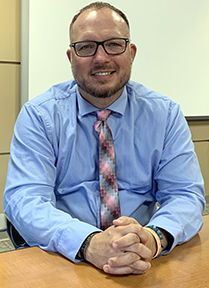One Veteran was raped and anguished over the murder of her daughter. Another was confronted daily with racism and sexism. And another was using alcohol to dull his pain. Each of them developed PTSD from their military experiences, but they also share something extraordinary: They’ve come out the other side with a renewed sense of life and purpose.
This phenomenon is known as post-traumatic growth, something that can result from those with post-traumatic stress disorder who are transformed and find a new mission as part of their treatment.
“It looks like this sort of deeper way of engaging with life and relationships around you,” said Milwaukee VA psychologist Cathy Coppolillo. “Often what you see first is a more subtle kind of internal change, like people coming to recognize themselves as having some strengths they didn’t know they had… Maybe they are starting to rediscover themselves as strong and resilient, understanding the world is full of possibility.”
For some, the new mission they embrace is helping others conquer their PTSD. Others take on new hobbies, sports or artistic endeavors. And others may focus on being the best person they can be.
“Folks who accept new reality can move forward.”
Five significant areas of growth have been identified in the Posttraumatic Growth Inventory:
- Relating to others
- New possibilities
- Personal strength
- Spiritual change
- Appreciation of life
The Posttraumatic Growth Inventory was developed by psychologist Richard G. Tedeschi, who pioneered the theory of post-traumatic growth in the 1990s, and his colleague Lawrence Calhoun.
Not everyone treated for PTSD achieves post-traumatic growth. For many, Coppolillo said, the goal of treatment is to get back to a semblance of normalcy and nothing more, or to equip oneself with the tools needed to fight the negative effects of PTSD.
“Early on, post-traumatic growth is not on most people’s radar,” she said. “But the folks who can really accept the new reality of their lives and their selves are the folks who can move forward and get to a place of post-traumatic growth.”
Those who do achieve post-traumatic growth typically are able to stare down a prevalent symptom of PTSD: avoidance.
“It’s a very human thing to pull back when stuff makes us anxious,” she added. “But the people who are most likely to attain post-traumatic growth are folks who don’t avoid: They stay engaged in relationships. They stay engaged in activities, even when they’re not feeling like it. There are people who take healthy risks, trying new things. And that’s one of the ways people end up finding these new meaningful activities and relationships.”
Read on as three Veterans tell their stories of achieving post-traumatic growth:
Murder, rape and hope
“I feel my mission is to tell my story,” said Carissa DiPietro. While her story is harrowing, it is also uplifting.
DiPietro, 44, joined the Army in April 1999. Her first major trauma came when she said she was raped by her recruiter and wasn’t offered any time to heal.
“When I got back to my unit, the first sergeant just sent me back to work,” she said. “There was no counseling or push to provide any help.”
Two weeks before 9/11, DiPietro’s 5-year-old daughter was murdered by her then-husband, in Germany.
“It was the worst abuse case the judge said he had ever seen,” she said.
While on funeral leave, the terrorist attacks occurred and DiPietro was ordered back to her unit, again with no recognition of the major trauma she had experienced.
“I pushed all these traumas down,” she said, noting that she devolved into the shell of her former person. “I had breath in my lungs and a beat to my heart, but I wasn’t alive.”
“I went on this huge path of healing.”
The turning point came when she signed up for the Feast of Crispian at the Milwaukee VA. Feast of Crispian uses theater to help Veterans address trauma.
In this setting (pictured above), DiPietro said she found her voice. She talked about her rape for the first time and was able to finally grieve for her daughter.
“It truly changed my life. I went on this huge path of healing,” she said.
DiPietro began pursuing photography and went back to school. She graduated from Milwaukee Area Technical College and is now enrolled at the University of Wisconsin-Milwaukee.
She shares her story with other Veterans in order to help them find their own path to healing. Through the Lake Arts Project, she has connected with high schoolers who have suffered trauma. She acknowledges that the PTSD will never go away, but she knows how to handle it.
“What happened to me was unnatural and horrible, but the way my mind reacted was totally natural,” she said. “I will spend the rest of my life healing, but I’m happy. I laugh every day, and I can cry, and I find that beautiful.”
“I focus on her life and the beauty of her life.”
DiPietro remembers when her PTSD treatment turned to growth. On the anniversary of her daughter’s death, she used to re-read the paperwork surrounding the trial. But she came to realize that wasn’t healthy.
“I had a ceremony and burned the paperwork,” she said. “At that moment, I shifted from PTSD to growth. I wasn’t going to live my life torturing myself. Now I focus on her life and the beauty of her life. I can’t take away that pain she went through, but I can tell her story and make a difference. I look at it as growth. I never thought I would live to 40. Now I have my whole life ahead of me with dreams for the future. I want to keep putting myself out there and keep pushing to do new things.”
And she has advice for Veterans who are struggling.
“You can do it. Everybody can do it. It just takes that phone call, that one step,” she said. “Find your group through VA. They will help you find it.”
Hitting the target
For Gwen Sheppard, a set of before-and-after photos says it all.
The before: Sheppard stands rigidly, not smiling, holding her air rifle at her first Air Force Wounded Warriors games.
The after: Five years later, a relaxed and beaming Sheppard smiles for the camera.
Those photos reflect Sheppard’s transformation in her fight against PTSD and the purpose and happiness she has found through air rifle and archery competition.
“This is just awesome,” the 59-year-old said. “I’ve got a purpose.”
Sheppard, a civil engineer, was deployed to Iraq as part of the Air Force Reserve in 2003.
In addition to the hardships of that deployment during one of the hottest summers on record in the region, she faced racism and sexism, even though she was an officer.
Read the rest of her story here.
Making more good shots
Chris Swift likes to play golf.
He admits he’s not any good, but he knows the feeling he gets when he hits a good shot – even though it may be preceded and followed by numerous bad ones.
And that’s the approach he takes when talking to Veterans struggling with PTSD.
“You have those good shots, and you have those interactions with people, and maybe you make a difference – you put an idea in their head and they get help,” he said.
Helping Veterans is Swift’s new-found purpose in life, which is quite different than just a few years ago, when he found himself sitting in a jail cell after getting arrested for his third charge of driving while intoxicated.
Plenty of heartbreak and anger
But that proved to be the turning point in his life.
Swift, 45, served as a medic in the Army, deploying numerous times to the Middle East. Those deployments yielded two things: Plenty of heartbreak as he saw comrades torn apart by explosives, and plenty of anger regarding incompetent superior officers and command decisions.
“We lost a lot of good guys… with quite a lot of guys getting injured,” he said. “It’s crazy. You see them and then all of the sudden, they’re not there.”
Even while in the military, he regularly used alcohol to numb himself against those emotions. He got his first DUI on a military base in the States, and he remembers nights filled with drinking and brawling.
Learn more about post-traumatic growth here.
Topics in this story
More Stories
Study underscores important role COVID vaccination can have in protecting Veterans from infection and reducing long-term health consequences
Columbia VA’s robotic surgery teams completed their 800th robotic surgery and are on schedule to hit 1,000 by the end of the year.
In a decentralized clinical trial, Veterans can participate from their own homes or local VA instead of having to travel to a research site.









I have suffered from PTSD for probily for more than 50 years for the time spent in Vietnam and Desert Storm. I was trying to control what I really didn’t understand why I had this rage and anger.
I started going to the VA in 96 or 97 to see what could be done about this PTSD problem. To make a long story short, I saw a couple of doctors and a physciotrist who put me on 2 meds, one being a narcotic and Zoloft but have to see a physciotrist every 6 months. This worked for about 2 to 3 years then seeing the physciotrist stopped as fast as it started. No more seeing the physciotrist, no reason why it stopped but the meds kept being mailed to me. I’ve contact the VA to find out why and never got an answer. I blame the VA for this screw up on their fault. The VA has a bad way of following up on Veterans. I just can’t say too many good things about the VA’s treatment methods and I am 100% disabled. Thank goodness for Medicare and Tri Care.
I am at the point where I have to have my wife help me shower because I have a tendency of falling, she has to help me dress because I can’t been over, she also has to help me with eating because I shack so bad. The VA gave me a scooter ith lift for my truck, a walker, cane, handicapped bathroom, railings on my steps to help me get around. I have fallen 6 times in the last 7 months, 1 time had I had 26 stitches in my head, but the will not approve aid and attendance because the VA tells me the examiners do not fill up the paperwork correctly. Can someone explain to me what the problems is with to VA. I now just say the hell with the VA because there is no help. This is very sad if other veterans have to go through simular problems.
Contact a Veteran Service Officer with the DAV, VFW or another group. Also, your VA Care Team should have a Social Worker. You should have them help you get the paperwork filled out properly. That is part of their job. Sending prayers
Yes, it took me a long time to open up as well. I did a great job of stuffing my PTSD for many years. I understand it better now but I also learned it will probably never leave me. I learned how to adapt and go on the best I could.
After suffering with PTSD for 50 years I wax finally determined tone clinical free of PTSD. In May 2020 I literally cracked under the strain of PTSD and began displaying bizarre behavior culminating in July 2020 when it was called to my attention resulting in me ending in court. It was a wake up call and I knew I needed help. Went to the VA . They turned me away. I found private doctor. Was successful treated. Now I cannot find anyone at the VA who will stand by me in court and explain to the court that those of us with military PTSD often display bizarre behavior. So frustrating.
Every veteran has their own story. With one variation a whole different set of outcomes is tn the realm of possibility. A deciding choice to seek assistance from VA sources is a life changing move.
I suffered a plethora of conditions, all unknown PTSD symptoms and conditions.
The kicker is that I did not understand what it all meant until I retired. The change in lifestyle affected me very negatively. The VA saved me.
Counseling, access to healthcare, and the long, hard trip to securing disability ratings, was brilliantly assisted by my CVSO.